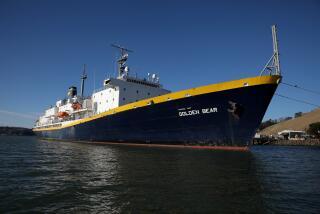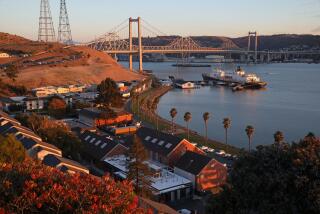Sailing Class Offers Lesson in Adventure
- Share via
If an ocean voyage to Hawaii and Alaska aboard a 65-foot sailboat sounds inviting, now is the time to turn in your application for the 8,000-mile Pacific sail training course offered by Orange Coast College.
Spots are available for only 56 students, but three times that many usually apply for berths during the unusual course, a learning adventure aboard the college-owned yacht, Alaska Eagle.
Although the boat does not sail until June 9, the application process began two days ago and continues through February. “For every 10 slots, we’ll have about 30 applicants,” said Brad Avery, director of the college’s sailing program. “But we like to have a lot of applicants to choose from. The success of the program depends upon being able to put a good crew together.”
However, Avery emphasizes that one need not be an expert sailor to be accepted as a crew member. “We’re looking for people with intermediate-level experience,” he said, “who want to learn about cruising and navigation. We tailor the program to meet the individual’s needs. So if someone wants to work on a certain skill, such as navigation, then we’ll work on that skill.”
Physical agility is more important than sailing experience, Avery said. “The biggest danger is slipping and falling. People need to be physically agile and comfortable on a heeled boat. We tread the line (between experience and inexperience) because we don’t want to scare people off.”
Students chosen will actually sail the boat during various passages of the six-leg, June-to-September cruise. A new crew (nine or 10 people, depending on the leg) will take over for each portion of the trip. The 2,100-mile first leg, from Newport Beach to Hawaii, is expected to take 12 days. The second leg, a cruise around the Hawaiian Islands, lasts 10 days. Then the boat will sail from Hawaii to Sitka, Alaska. This 2,500-mile passage is perhaps the most adventurous, according to Avery, and will take 13 to 15 days.
From Sitka, the boat will sail to Ketchikan in a 10-day cruise that will include stops in the Tongass National Forest, Juneau and Anan Creek (famous for bear-watching). From Ketchikan, the Alaska Eagle will sail 60 miles up Behm Canal for an overnight stay in the Punchbowl, an anchorage surrounded by huge glacier-carved granite walls. Then students sail 90 miles offshore to Canada’s remote Queen Charlotte Islands, then southeast to Vancouver Island. The final leg, from Vancouver to Newport Beach, is expected to take 19 days, with Alaska Eagle returning to Orange County in late September.
“Exploring Glacier Bay is spectacular,” Avery said. “Alaska Eagle is small enough so that we can get in the nooks, crannies and coves and really explore the area. We do some fishing, killer whale-watching. We learn a lot, but we do have a good time, too.”
Orange Coast College instructors Richard and Sheri Crowe will skipper the boat during the first three legs, and Avery will take over for final three. The Crowes have sailed the Alaska Eagle across the Pacific six times. And both have sailed on other Pacific crossings and have cruised extensively in England, the Virgin Islands and Mexico. Avery has crossed the Atlantic four times and has made seven Pacific crossings, four of them in Transpac races. All three instructors are Coast Guard licensed.
Many students who sign up for the Alaska Eagle cruise start out in the OCC sailing program in smaller boats and work their way up, Avery said. “They start in Lido 14s and say, ‘What do I have to do to sail aboard the Alaska Eagle?’ ” he said.
During the 8,000 mile-voyage, students hone their offshore skills in navigation, piloting and sail handling.
The college began the Pacific sail training course in 1983, the year after the Alaska Eagle was donated to the college by Neil G. Bergt, an Alaska businessman who sailed the boat in the Whitbread race around the world. The college offers the Pacific cruise to Hawaii every year, but the Alaska portion is offered only every two years. When the boat is not cruising the Pacific, it is used for sail training in local waters.
Training for the trip begins in March. “We want them to get comfortable with the boat and how to run it,” Avery said. Every student who signs up for the cruise must participate in a “work day” and a “safety day” aboard the boat. During the work day, crew members give the boat a thorough cleaning and do an inventory of the gear. On safety day, they practice man-overboard and fire drills and learn about the boat’s bilge system, emergency gear and medical kit.
“We have had no accidents,” Avery said. “Initially, it was hard for us to get insurance for the cruise, but not any more. In fact, our insurance rates have dropped because of our good safety record.”
Even so, the boat has faced its share of dangers, including a 50-knot gale off the coast of Oregon. “Every leg presents it challenges and dangers. Sailing in the Hawaiian Islands is rugged. Passages between islands are rough. But it’s a thrilling sail. And the boat is big enough to handle it.”
The college’s costs of operating the cruise total about $75,000, all of which are paid by the participants. During past cruises, participants have ranged in age from 17 to 60, Avery said. “Nearly 80% (of the crew) are men,” he said. “We’d like to see more women become involved.”
To find out more about the voyage, write Alaska Eagle Cruise, OCC Community Services, P.O. Box 5005, Costa Mesa, Calif. 92628. Or call (714) 645-9412.
More to Read
Sign up for The Wild
We’ll help you find the best places to hike, bike and run, as well as the perfect silent spots for meditation and yoga.
You may occasionally receive promotional content from the Los Angeles Times.






